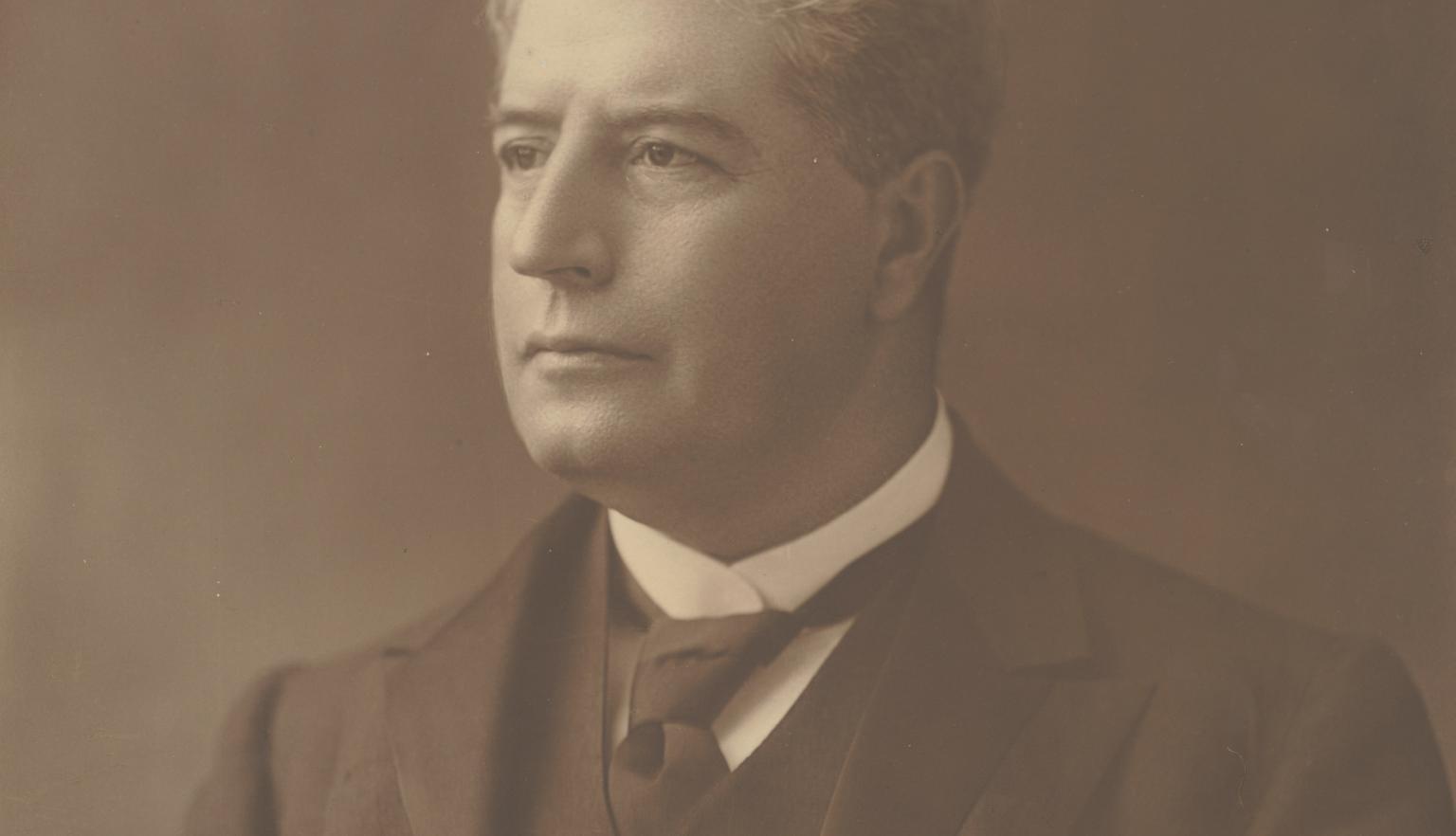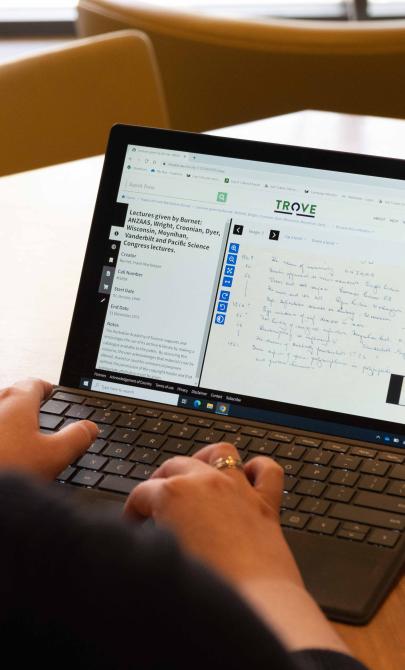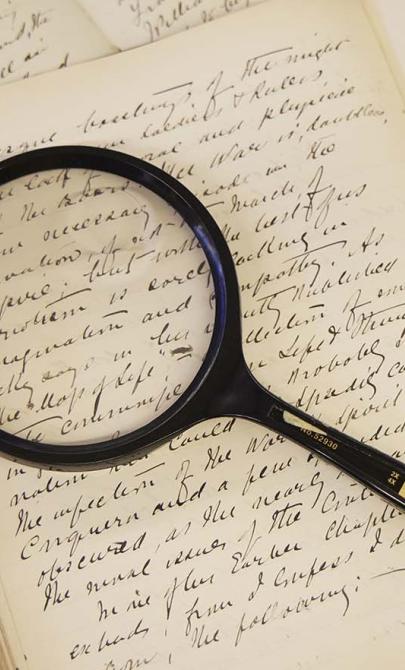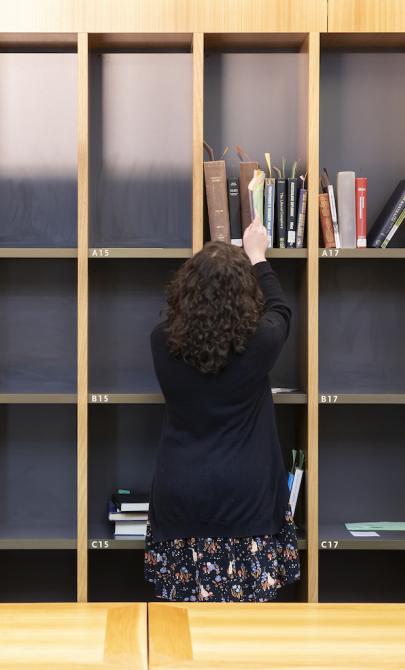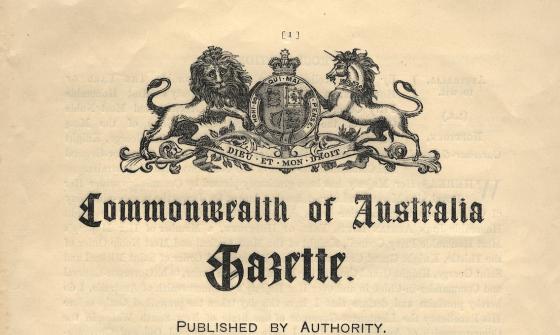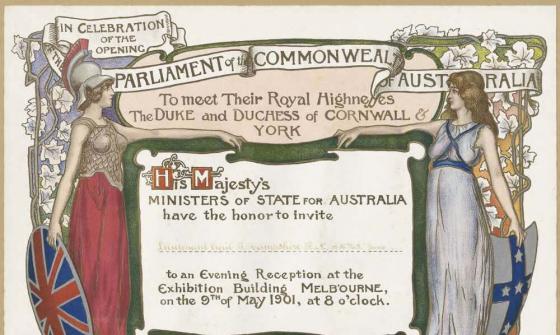Federation of Australia
Collection highlights
Key items in the collection
This collection hosts a range of formats, including:
We hold the most comprehensive collection of original records of the Federation movement. They range from official correspondence and working papers of the Federal Conventions and committees to private letters, diaries, and an assortment of printed ephemera associated with the Conventions and the Commonwealth celebrations in 1901. The following are the principal collections held by the Library.
Records of the Australasian Federation League of New South Wales, 1871-1909
Records of Australasian Federation League of New South Wales retained by its secretary, Edward Dowling. They comprise correspondence (1890-1910), letterbooks, minutebooks (1893-1911), financial records, subject files, reports, handbills, pamphlets and a manuscript by Dowling.
Papers of Sir Edmund Barton, 1827-1940
Papers of Sir Edmund Barton, New South Wales parliamentarian and delegate to the Federal Conventions, 1891, 1897-98. The papers include correspondence with political leaders in Australia and Britain, speeches, many drafts of the Commonwealth Constitution Bill, and newspaper cuttings.
Papers of Sir William Lyne, New South Wales Premier and parliamentarian and delegate to the 1897-98 Federal Convention. They consist of letters and telegrams concerning his unsuccessful attempt to form the first Commonwealth Government in December 1900.
Papers of Sir John Kirwan, 1899-1935
Papers of Sir John Kirwan, Western Australian journalist and later parliamentarian. The papers include letters on the Federal campaign, including agitation in favour of Federation on the Western Australian goldfields.
Correspondence of Walter Hartwell James, 1897-1913
Papers (copies) of Sir Walter James, West Australian parliamentarian and delegate to the Federal Convention, 1897-98. They include letters of Deakin, Barton, Wise and other leaders of the Federal campaign.
Miscellaneous papers, 1879-1916
Papers of Sir Henry Turner, Victorian Premier and parliamentarian and delegate to the Federal Convention, 1897-98. They consist largely of printed ephemera such as programs, menus, invitations, tickets and speeches, mostly in relation to the Commonwealth celebrations in 1901.
Papers of J.D. Holmes, lawyer, judge and bibliographer. The papers include a bibliography of Federation, 1841-1901.
Papers of Lord Tennyson, 1895-1919
Papers of Lord Tennyson, Governor of South Australia in 1899-1902. The papers include many letters of Lady Tennyson referring to Federation.
Correspondence of Christopher Crisp, 1877-1916
Papers (copies) of Christopher Crisp, Victorian journalist. The papers consist of correspondence with Deakin and other leaders of the Federal movement.
Papers of Henry Higgins, 1840-1976, bulk 1841-1929
Papers of H.B. Higgins, Victorian parliamentarian and delegate to the 1897-98 Federal Convention. The papers include correspondence and newspaper cuttings of the Federation period.
Papers of Alfred Deakin, 1804-1973
Papers of Alfred Deakin, Victorian parliamentarian and delegate to all the Federal conferences and Conventions, 1890-98. They include an extensive correspondence, diaries, notebooks, notes for speeches, drafts of the Commonwealth Constitution Bill, printed ephemera relating to the federal Conventions, newspaper cuttings and the manuscript of The Federal Story.
Papers of Bernard Ringrose Wise, 1897-1898
Papers of B.R. Wise, New South Wales parliamentarian and delegate to the 1897-98 Federal Convention. They comprise notes and letters of Andrew Inglis Clark.
Papers of Sir Josiah Symon, 1820-1959
Papers of Sir Josiah Symon, South Australian parliamentarian and delegate to the 1897-98 Convention. Among the papers are correspondence with political leaders, Convention documents and newspaper cuttings.
Family papers of Robert Garran, 1842-1957
Papers of Sir Robert Garran, private secretary to George Reid and secretary to the Drafting Committee at the 1897 Convention. They include notes and speeches on the federal campaign and a volume of documents relating to the 1897-98 Convention.
Souvenir programmes, invitations, etc. 1897-1951
Papers of Sir Frederick Holder, South Australian Premier and parliamentarian and delegate to the 1897-98 Federal Convention. They consist of menus, invitations and other printed ephemera.
Papers of Sir Isaac Isaacs, 1883-1969
Papers of Sir Isaac Isaacs, Victorian parliamentarian and delegate to the 1897-98 Federal Convention. They include annotated drafts of the Commonwealth Constitution Bill.
Papers of Patrick McMahon Glynn, 1874-1931
Papers of Patrick McMahon Glynn, South Australian parliamentarian and delegate to the 1897-98 Convention. They include diaries, notebooks, speeches and cutting books.
Papers of L. F. Crisp, 1878-1984
Papers of L.F. Crisp, political scientist and author of Federation fathers (1990). They include correspondence and the manuscripts of his Federation monographs (1979-84).
Papers of John Andrew La Nauze, 1888-1984
Papers of J.A. La Nauze, historian and author of Alfred Deakin (1965) and The making of the Australian Constitution (1972). They include correspondence, copies of documents and research material on Deakin and the Federal movement.
Papers of Frank Crowley, 1933-2009
Papers of F.K. Crowley, historian and author of Big John Forrest 1847-1918 (2000). They include an unpublished typescript, ‘Forrest the politician, 1891-1918’.
The Australian Joint Copying Project microfilmed Colonial Office records documenting the British response to the Federation movement, including the negotiations between the Australian delegates and the British Government in 1900. In addition, it filmed personal papers of several ministers and governors who took an interest in Federation.
- Papers of Sir Anthony Musgrave (M412)
- Collections held by the University of Birmingham (M867-68)
- Papers of John Hope, 7th Earl Hopetoun, Governor of Victoria (M936-37)
- Records of Royal Commonwealth Society (M1698-1703)
- Collections held by Surrey Record Office relating to New Zealand and Australia (M1840)
- Papers of the Stanhope Family (M1904)
- Papers of Edward Henry Stanley, 15th Earl of Derby (M1969-72 )
- Collections held by the Gloucestershire Record Office relating to Australia and New Zealand (M 2290)
- Australia: Acts: Federal Council, 1886-97 (mfm PRO 2127)
- Confidential prints: Draft Federal Council Bill, 1884 (C.O. 881/6) (mfm G 7446)
- Confidential prints: Federation of Australian colonies, 1897-99 (C.O. 881/10) (mfm G 7451)
We hold the music scores of a substantial number of patriotic songs which were written in support of Federation and to celebrate the inauguration of the Commonwealth. The following are some examples.
- Marcus L. Adney, Rise! Australia: Australian national anthem, 1899
- John C. Burn, The star of Australia: a Federation song, 1899
- Arthur Chanter, Australians all: national song and anthem, 1898
- V.De Giorgio, Australian Commonwealth triumphal march, c. 1900
- Joseph Gillott, Australia’s cherished dream: a song of the Commonwealth, c. 1901
- M. Heuzenroeder, Australia, c. 1900
- Laura Landseer, Federation waltz, 1895-1900
- S. McBurney, The flag of union: a Federation song, c. 1901
- P.D. McCormick, Advance Australia fair, c. 1879
- John H. Nicholson, Sons of Britannia: a Federation song, n.d.
- Thomas A. Ricketts, Federation polka, c. 1900
- Toso Taylor, United Australia: national song and chorus, c. 1898
- Hampton Wood, Australia’s emblem waltz, 1891-92
We hold a small group of paintings, drawings, cartoons and prints of prominent figures in the Federation movement. The following are some examples:
- Harry G. Banks, Portrait of B.R. Wise (photograph), 1898
- J.H Chinner, Portrait of Alfred Deakin (ink and wash), c. 1910
- J.H Chinner, Portrait of Edmund Barton (pen and wash), n.d.
- J.H Chinner, Portrait of Sir Henry Parkes (watercolour), 1893
- H. Cotton, Federated Australia (pen and ink), 1900
- H. Cotton, Portrait of Sir Henry Parkes (pen and ink), 1900
- H. Cotton, Toby or not to be? that is the question (ink cartoon), 1900
- W.H. Gocher, Portrait of William Lyne (oil), c. 1900
- Talma & Co,Portrait of Sir Samuel Griffith (photograph), n.d.
- Livingston Hopkins, The Federal child (pen and ink cartoon), n.d.
- C.W. Readett, The Federal Works (watercolour cartoon), c. 1898
Bibliography
- John Bannon, Supreme federalist: the political life of Sir John Downer, 2009
- Scott Bennett ed., Federation, 1975
- Scott Bennett ed., The making of the Commonwealth, 1971
- Geoffrey Bolton, Edmund Barton, 2000
- Judith Brett The enigmatic Mr Deakin, 2017
- Zelman Cowen Isaac Isaacs, 1967
- L.F. Crisp, Federation fathers, 1990
- F.K. Crowley, Big John Forrest 1847-1918: a founding father of the Commonwealth of Australia, 2000
- Margaret Glass, Charles Cameron Kingston: federation father, 1997
- Peter M. Gunnar, Good Iron Mac: the life of Australian federation father Sir William McMillan, KCMG, 1995
- Marcus Haward and James Warden, eds, An Australian democrat; the life, work and consequences of Andrew Inglis Clark, 1995
- P.A. Howell, South Australia and federation, 2002
- Helen Irving, The Centenary companion to Australian federation, 1999
- Helen Irving, To constitute a nation; a cultural history of Australia's constitution,1997
- R.B. Joyce, Samuel Walker Griffith, 1984
- J.A. La Nauze, Alfred Deakin, 2 vols, 1965
- J.A. La Nauze, The making of the Australian Constitution, 1972
- W.G. McMinn, George Reid, 1989
- A.W. Martin, Essays in Australian federation, 1969
- A.W. Martin, Henry Parkes, 1980
- Ronald Norris, The emergent Commonwealth: Australian federation, expectations and fulfilment, 1889-1910, 1975
- Gerald O'Collins, Patrick McMahon Glynn: a founder of Australian federation, 1965
- John Rickard, H.B. Higgins, the rebel as judge, 1984
- Roslyn Russell and Philip Chubb, One destiny! The federation story, how Australia became a nation, 1998
- John M. Williams, The Australian Constitution, a documentary history, 2005
Primary accounts
- Andrew Inglis Clark, Studies in Australian constitutional law, 1901
- Alfred Deakin, The federal story; the inner history of the federal cause, edited by Herbert Brookes, 1944 [later editions edited by J.A. La Nauze (1963) and Stuart Macintyre (1995)]
- Federal Council of Australasia, Official records of debates, 8 vols, 1886-99
- Robert Garran, Prosper the Commonwealth, 1958
- H.B. Higgins, Essays and addresses on the Australian Commonwealth Bill, 1900
- William Harrison Moore, The Constitution of the Commonwealth of Australia, 1902
- Official record of the proceedings and debates of the National Australasian Convention, 1891
- Official record of the debates of the Australasian Federal Convention, 4 vols, 1897-98
- Henry Parkes, Fifty years in the making of Australian history, 1892
- John Quick, Sir John Quick's notebook, edited by L.E. Fredman, 1965
- John Quick and Robert Randolph Garran, The annotated constitution of the Commonwealth of Australia, 1901
- George H. Reid, My reminiscences, 1917
- B.R. Wise, The making of the Australian Commonwealth, 1889-1900; a stage in the growth of the Empire, 1913
We hold photographs of most of the figures in the Federation movement. In the case of leading figures, such as Barton, Deakin, Griffith, Kingston, Isaacs and Parkes, there are many photographs, often ranging from childhood to old age. There are also photographs of the delegates attending the 1890 Conference and the 1891 and 1897-98 Conventions, including some of the committees.
There are an extraordinary number of photographs of the celebrations surrounding the inauguration of the Commonwealth on 1 January 1901 and the opening of the Federal Parliament in Melbourne in May 1901. In addition to loose photographs, there are 24 albums documenting the decorations, parades and other celebrations, and the tour by the Duke and Duchess of York, in various parts of Australia. Some of the albums contain not only photographs but also memorabilia and newspaper cuttings.
About federation in Australia
The idea of uniting the six Australian colonies into a federation was discussed from the 1850s. Support grew after the Canadian colonies federated in 1867, but progress was slow. The first formal step was the establishment of the Federal Council of Australasia in 1885. However, it had no real power, and New South Wales refused to join, making the council ineffective.
Push for federation
In October 1889, Sir Henry Parkes, a prominent New South Wales politician, called for a federation with a strong executive, controlled by the people, to ensure the colonies' defence. Following this, an informal conference was held in Melbourne in 1890, leading to a convention in Sydney in 1891. At this convention, a draft Constitution was created but faced opposition, particularly in New South Wales.
By 1893, public support for federation grew, with the formation of federation leagues in many colonies. A major conference in Corowa, New South Wales, helped build momentum. In 1895, the premiers agreed to hold a new convention, with delegates elected by the people.
The federal convention
The Federal Convention met several times between 1897 and 1898 in Adelaide, Sydney, and Melbourne. They drafted a Constitution Bill, which was later approved by referenda in most colonies. While all colonies supported federation, New South Wales had only a narrow majority.
In 1900, representatives from the colonies went to London to meet with Joseph Chamberlain, the Secretary of State for the Colonies. After a few amendments, the British Parliament passed the Constitution Bill, and Queen Victoria approved it on 9 July 1900.
Federation achieved
On 1 January 1901, the six colonies officially united to form the Commonwealth of Australia. The first Governor-General, Lord Hopetoun, appointed Edmund Barton as the head of the new government. Australia's first Parliament was opened by the Duke of York in Melbourne on 9 May 1901.
Background to the collection
The National Library owes its existence to Federation and from the beginning it set out to document the Federation movement. In 1903 it announced that it was seeking complete records of Federation from every possible source. The first substantial manuscript collection acquired by the Library was the archives of the Australasian Federation League of New South Wales, purchased from Edward Dowling in 1912. The Federation papers of Sir Edmund Barton were donated by his family in 1928, while the papers of Alfred Deakin were presented by his daughter in 1965.
The records of the Australasian Federation League of New South Wales and the papers of various figures in the Federation movement are held in the Manuscripts Collection. In most cases, there are finding-aids which describe the papers in some detail and which usually include indexes of correspondence. Most of the finding-aids are accessible on the Library’s Website. Review the digitised papers of Sir Edmund Barton and the papers of Alfred Deakin.
The microfilms are available in the Newspaper and Microcopy Reading Room. Descriptions of the papers of Joseph Chamberlain and Lord Hopetoun can be found in Part 8 of the Australian Joint Copying Project Handbook.
The paintings, drawings, prints and photographs are held in the Pictures Collection at various locations. They have been catalogued individually. The photograph albums are numbered 322-44 and 379. Many of the individual photographs are filed under the heading Australia: Federation.
The songs and marches are held in the Music Collection, while the publications are in the Australian Collection. They have all been catalogued individually.
The papers of Sir Henry Parkes, which form an extremely large archive, are held in the Mitchell Library in the State Library of New South Wales. The papers of Sir Samuel Griffith are in the Dixson Library in the State Library of New South Wales. The papers of Andrew Inglis Clark are held in the University of Tasmania Archives.
This guide was prepared using this reference:
- S.G.Foster, Susan Marsden and Roslyn Russell, Federation: the guide to the records, Canberra, 1998, nla.gov.au/nla.cat-vn253814
